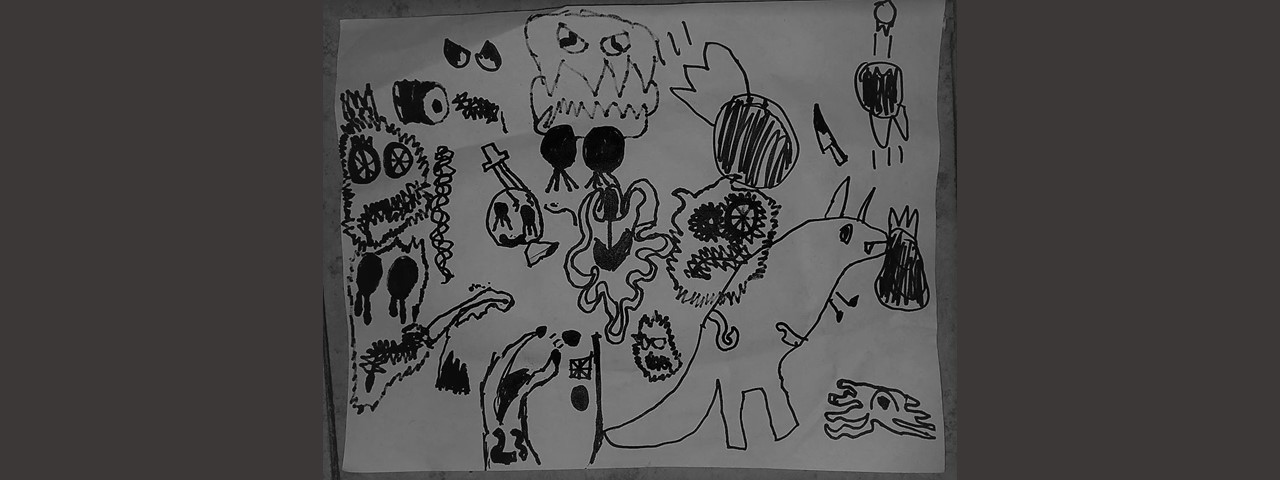
Picture description: “Dinosaur is saving the world”. Under his head, there’s an “octopus taking a nap”. At the left of the dinosaur tail, there’s a “basketball dude doing random stuff”. At the center of the masterpiece, there’s a “bacteria demon”. Over the demon, there are two “eyes staring into your soul”. At the left side of the demon, there’s a “monster that was slayed”.
We know that the Olympic barbell should be used to perform the snatch, the clean and jerk, the squat, the bench press and the deadlift. The military press, as all the assistance exercises for both Olympic Weightlifting and Powerlifting, are accepted but curls are frowned upon. However, when the Olympic barbell was introduced in the market there were about 130 barbell lifts. Some may look a bit silly and some are a mystery: we only have pictures and we have no idea how they were performed. People still enjoy the “odd” or “all-round” lifts as evidenced by the existence of the Odd Lift Strength Association and the United States All-Round Weightlifting Association.
A barbell is a beautiful piece of equipment but it doesn’t forbid anything nor does it teach one to use it in any particular way. The same goes for a chair, a rope or a Coke bottle.
Culture attributes purpose to things and as we grow up, we forget that the power to attribute purpose belongs to us. We take the “accepted” or marketed purpose as something given.
Children, however, are born free of these constraints. A shelf is not a thing to store books and other objects. It might be something to climb and many domestic accidents happen because we forget that children are not as domesticated as we are. They are free to purpose and repurpose everything around them.
What happens when an unrestrained child enjoying the full power of their innate creativity and curiosity is let (somewhat) loose in a gym? They explore the environment and soon will experiment with repurposing objects.
The following videos illustrate what happens when Daniel (8 years old) enjoys his unstructured time at the gym. Daniel is particularly gifted concerning curiosity, creativity and innovation but at some degree, all kids, if not quenched in their abilities, will repurpose things.
Observation and upside-down swinging equipment
The 500 lat pulldown and tonnage calculus
View this post on Instagram
Daniel's lat pull down tonnage calculus - here for embedding on article
A post shared by Marilia Coutinho, Ph.D. (@marilia_coutinho) on
The box-to-box long jump
View this post on Instagram
Daniel's box-to-box long jump - here for embedding in article A post shared by Marilia Coutinho, Ph.D. (@marilia_coutinho) on
The very old idea (van der Fels et al 2015, Donnelly et al 2016, de Greeff et al 2018, Spender et al 2011) that cognitive and motor development are coupled in children is evidenced on Daniel’s videos.
The lat pulldown challenge was a combination of exercise science (what is fatigue? What does it feel like?) arithmetic (the calculus of total tonnage for the 500 pulls) and mechanics.
It’s too bad that conventional child school education ignores the infinite opportunities to make use of children’s innate capacity to integrate knowledge (much faster and efficiently than domesticated adults).
Daniel is given serious strength and conditioning challenges and even if he struggles, he never gives up. Grit and fun are also factors here. Daniel's deadlift
View this post on Instagram
Daniel's deadlift- here for embedding in article
A post shared by Marilia Coutinho, Ph.D. (@marilia_coutinho) on
At least he will not be a victim of fragmentation. I suspect that there is no system powerful enough to quench his inexhaustible creativity, ability to connect the dots and grit.
Maybe, just maybe, there are more Daniels out there. I hope so: in great part, the future of humanity depends on wild, undomesticated minds and bodies.
References:
van der Fels, Irene MJ, Sanne CM te Wierike, Esther Hartman, Marije T. Elferink-Gemser, Joanne Smith, and Chris Visscher. "The relationship between motor skills and cognitive skills in 4–16 year old typically developing children: A systematic review." Journal of science and medicine in sport 18, no. 6 (2015): 697-703.
Donnelly, Joseph E., Charles H. Hillman, Darla Castelli, Jennifer L. Etnier, Sarah Lee, Phillip Tomporowski, Kate Lambourne, and Amanda N. Szabo-Reed. "Physical activity, fitness, cognitive function, and academic achievement in children: a systematic review." Medicine and science in sports and exercise 48, no. 6 (2016): 1197.
de Greeff, Johannes W., Roel J. Bosker, Jaap Oosterlaan, Chris Visscher, and E. Hartman. "Effects of physical activity on executive functions, attention and academic performance in preadolescent children: a meta-analysis." Journal of science and medicine in sport 21, no. 5 (2018): 501-507.
Spencer, John P., Sammy Perone, and Aaron T. Buss. "Twenty years and going strong: A dynamic systems revolution in motor and cognitive development." Child Development Perspectives 5, no. 4 (2011): 260-266.








